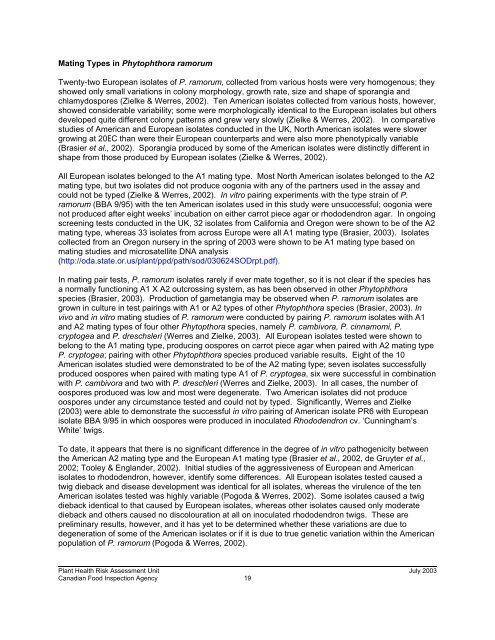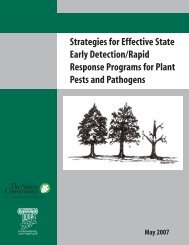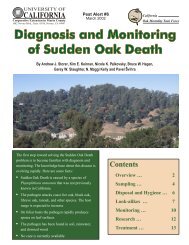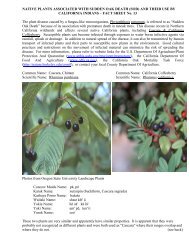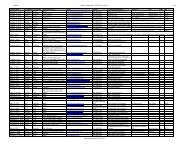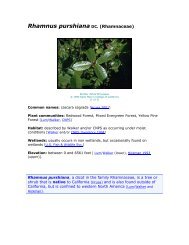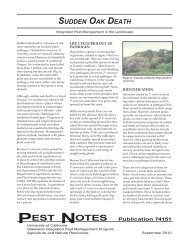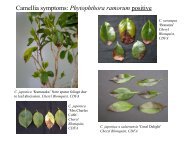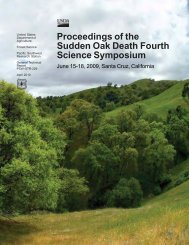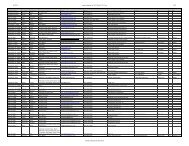Hosts of Phytophthora ramorum, CFIA, July, 2003 - Sudden Oak Death
Hosts of Phytophthora ramorum, CFIA, July, 2003 - Sudden Oak Death
Hosts of Phytophthora ramorum, CFIA, July, 2003 - Sudden Oak Death
You also want an ePaper? Increase the reach of your titles
YUMPU automatically turns print PDFs into web optimized ePapers that Google loves.
Mating Types in <strong>Phytophthora</strong> <strong>ramorum</strong><br />
Twenty-two European isolates <strong>of</strong> P. <strong>ramorum</strong>, collected from various hosts were very homogenous; they<br />
showed only small variations in colony morphology, growth rate, size and shape <strong>of</strong> sporangia and<br />
chlamydospores (Zielke & Werres, 2002). Ten American isolates collected from various hosts, however,<br />
showed considerable variability; some were morphologically identical to the European isolates but others<br />
developed quite different colony patterns and grew very slowly (Zielke & Werres, 2002). In comparative<br />
studies <strong>of</strong> American and European isolates conducted in the UK, North American isolates were slower<br />
growing at 20EC than were their European counterparts and were also more phenotypically variable<br />
(Brasier et al., 2002). Sporangia produced by some <strong>of</strong> the American isolates were distinctly different in<br />
shape from those produced by European isolates (Zielke & Werres, 2002).<br />
All European isolates belonged to the A1 mating type. Most North American isolates belonged to the A2<br />
mating type, but two isolates did not produce oogonia with any <strong>of</strong> the partners used in the assay and<br />
could not be typed (Zielke & Werres, 2002). In vitro pairing experiments with the type strain <strong>of</strong> P.<br />
<strong>ramorum</strong> (BBA 9/95) with the ten American isolates used in this study were unsuccessful; oogonia were<br />
not produced after eight weeks’ incubation on either carrot piece agar or rhododendron agar. In ongoing<br />
screening tests conducted in the UK, 32 isolates from California and Oregon were shown to be <strong>of</strong> the A2<br />
mating type, whereas 33 isolates from across Europe were all A1 mating type (Brasier, <strong>2003</strong>). Isolates<br />
collected from an Oregon nursery in the spring <strong>of</strong> <strong>2003</strong> were shown to be A1 mating type based on<br />
mating studies and microsatellite DNA analysis<br />
(http://oda.state.or.us/plant/ppd/path/sod/030624SODrpt.pdf).<br />
In mating pair tests, P. <strong>ramorum</strong> isolates rarely if ever mate together, so it is not clear if the species has<br />
a normally functioning A1 X A2 outcrossing system, as has been observed in other <strong>Phytophthora</strong><br />
species (Brasier, <strong>2003</strong>). Production <strong>of</strong> gametangia may be observed when P. <strong>ramorum</strong> isolates are<br />
grown in culture in test pairings with A1 or A2 types <strong>of</strong> other <strong>Phytophthora</strong> species (Brasier, <strong>2003</strong>). In<br />
vivo and in vitro mating studies <strong>of</strong> P. <strong>ramorum</strong> were conducted by pairing P. <strong>ramorum</strong> isolates with A1<br />
and A2 mating types <strong>of</strong> four other Phytopthora species, namely P. cambivora, P. cinnamomi, P.<br />
cryptogea and P. dreschsleri (Werres and Zielke, <strong>2003</strong>). All European isolates tested were shown to<br />
belong to the A1 mating type, producing oospores on carrot piece agar when paired with A2 mating type<br />
P. cryptogea; pairing with other <strong>Phytophthora</strong> species produced variable results. Eight <strong>of</strong> the 10<br />
American isolates studied were demonstrated to be <strong>of</strong> the A2 mating type; seven isolates successfully<br />
produced oospores when paired with mating type A1 <strong>of</strong> P. cryptogea, six were successful in combination<br />
with P. cambivora and two with P. dreschleri (Werres and Zielke, <strong>2003</strong>). In all cases, the number <strong>of</strong><br />
oospores produced was low and most were degenerate. Two American isolates did not produce<br />
oospores under any circumstance tested and could not by typed. Significantly, Werres and Zielke<br />
(<strong>2003</strong>) were able to demonstrate the successful in vitro pairing <strong>of</strong> American isolate PR6 with European<br />
isolate BBA 9/95 in which oospores were produced in inoculated Rhododendron cv. ‘Cunningham’s<br />
White’ twigs.<br />
To date, it appears that there is no significant difference in the degree <strong>of</strong> in vitro pathogenicity between<br />
the American A2 mating type and the European A1 mating type (Brasier et al., 2002, de Gruyter et al.,<br />
2002; Tooley & Englander, 2002). Initial studies <strong>of</strong> the aggressiveness <strong>of</strong> European and American<br />
isolates to rhododendron, however, identify some differences. All European isolates tested caused a<br />
twig dieback and disease development was identical for all isolates, whereas the virulence <strong>of</strong> the ten<br />
American isolates tested was highly variable (Pogoda & Werres, 2002). Some isolates caused a twig<br />
dieback identical to that caused by European isolates, whereas other isolates caused only moderate<br />
dieback and others caused no discolouration at all on inoculated rhododendron twigs. These are<br />
preliminary results, however, and it has yet to be determined whether these variations are due to<br />
degeneration <strong>of</strong> some <strong>of</strong> the American isolates or if it is due to true genetic variation within the American<br />
population <strong>of</strong> P. <strong>ramorum</strong> (Pogoda & Werres, 2002).<br />
Plant Health Risk Assessment Unit <strong>July</strong> <strong>2003</strong><br />
Canadian Food Inspection Agency 19


